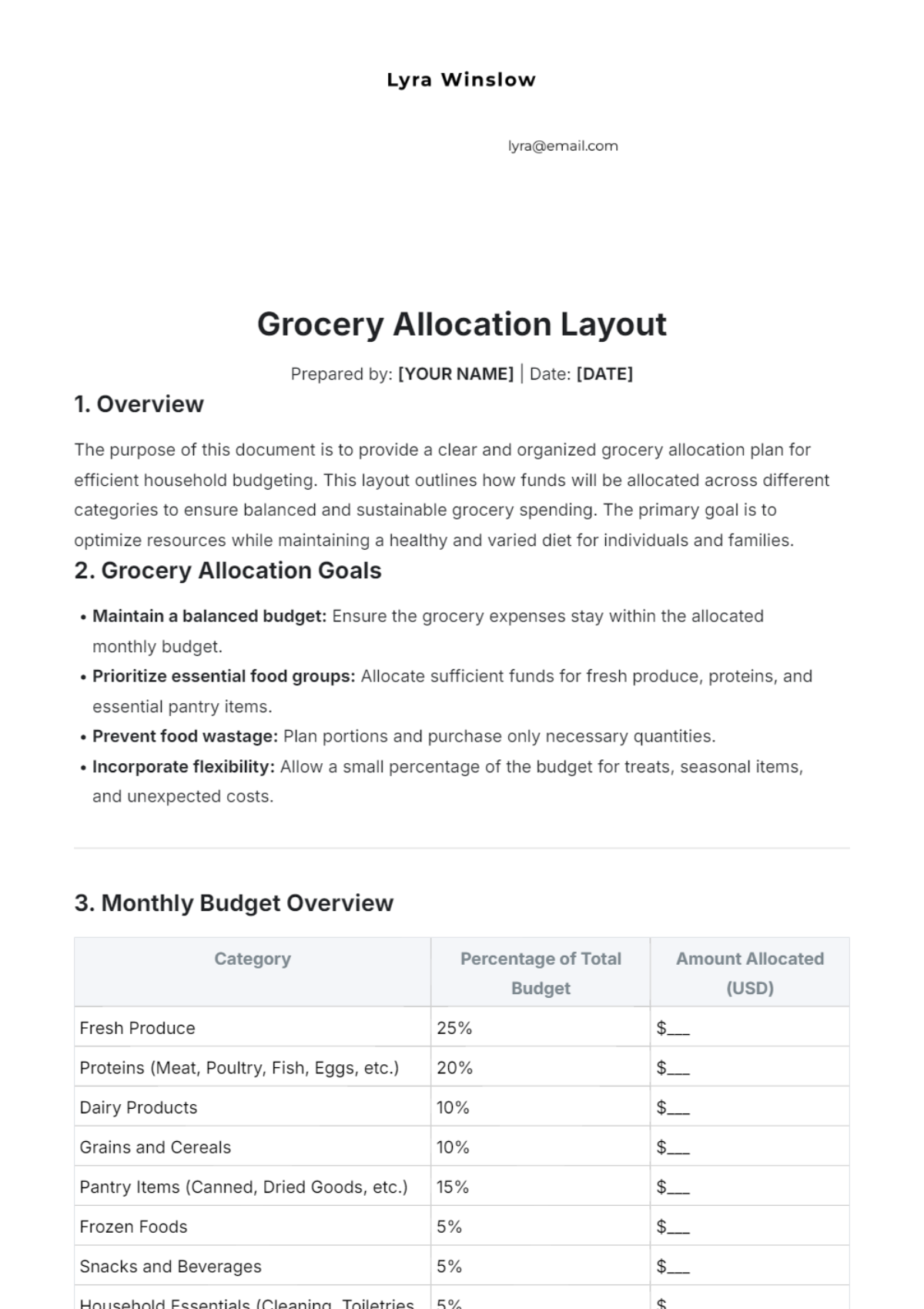Grocery Store Stock Management Guideline Design
I. Introduction
A. Purpose
The aim of [Your Company Name]'s guideline is to create a detailed and all-encompassing framework specifically for the management of inventory in our grocery store. Through the implementation of this structured approach, we seek to ensure that our methods for handling stock are both consistent and efficient. The document has been meticulously crafted to enhance the accuracy of our inventory records, minimize waste, and ultimately boost the overall performance of the store. This will be achieved by clearly delineating the proper procedures and best practices that need to be followed.
B. Scope
This guideline comprehensively covers every facet of inventory management. It includes detailed protocols and procedures for receiving incoming goods, storing items appropriately, replenishing stock as necessary, and conducting audits to ensure accuracy and accountability. This guideline applies to all store employees involved in inventory tasks, from stock clerks to management, ensuring consistent and efficient inventory practices.
C. Audience
The intended audience for this guideline encompasses a broad range of individuals who play critical roles in the inventory management process. Specifically, it is designed for inventory managers, stock clerks, and store managers. This guideline is crucial for all staff in inventory management, serving as a reference for new hires and offering a standardized approach for experienced employees to optimize their practices.
II. Inventory Management Principles
A. Inventory Accuracy
Importance of Accuracy
It is essential to maintain accurate inventory records to ensure stock levels are adequately aligned with customer demand, thereby avoiding both the pitfalls of overstocking and the risks associated with running out of products. The reliability of data plays a pivotal role in this context, as it not only aids in preventing financial discrepancies but also contributes significantly to minimizing operational disruptions.
Methods for Accuracy
To ensure accuracy in inventory management, it is essential to implement a rigorous process where regular physical counts of all inventory items are conducted. Physical counts should be reconciled with inventory records to identify and correct discrepancies. Using barcode scanning technology enhances accuracy and reliability, streamlining the inventory process and ensuring up-to-date records for better decision-making and efficiency.
B. Stock Rotation
FIFO (First In, First Out)
Applying the FIFO method ensures that older inventory is sold before newer stock, which is vital for perishable items. This practice reduces spoilage and helps maintain product quality, enhancing customer satisfaction.
LIFO (Last In, First Out)
For certain non-perishable goods, the LIFO method may be employed to prioritize selling the most recently received stock. This method can be useful in managing items with long shelf lives or those that are less susceptible to obsolescence.
C. Supplier Relationships
Supplier Selection
Choose suppliers based on their reliability, product quality, and competitive pricing. Establish long-term relationships with trusted suppliers to ensure consistent product availability and favorable terms.
Communication Protocols
Develop clear communication protocols for placing orders, resolving issues, and receiving updates on products. Regularly review supplier performance and address any concerns to maintain effective partnerships.
D. Demand Forecasting
Data Collection
Gather data from sales reports, seasonal trends, and promotional activities to develop accurate demand forecasts. Analyze historical data and market trends to predict future inventory needs effectively.
Forecasting Techniques
Use statistical tools and software to create predictive models for inventory demand. Regularly adjust forecasts based on real-time sales data and market changes to refine accuracy.
III. Stock Control Procedures
A. Receiving Stock
Inspection Procedures
Upon receipt of stock, inspect all items for compliance with purchase orders, checking for correct quantities and quality. Report any discrepancies or damages immediately to ensure timely resolution.
Documentation and Record-Keeping
Record all received goods in the inventory management system, including details from purchase orders and delivery notes. Maintain organized documentation for auditing and future reference.
Storage Guidelines
Store products in designated areas based on their type and storage requirements to optimize space and ensure safety. Regularly review and adjust storage practices to accommodate changes in inventory and store layout.
B. Stock Shelving
Organization and Layout
Arrange products on shelves according to predefined planograms to maximize space and enhance product visibility. Ensure that high-demand and promotional items are prominently displayed.
Visibility and Accessibility
Maintain clear and accessible shelves to facilitate easy customer browsing and minimize stock retrieval time. Regularly review shelf organization to ensure products are easy to find and reach.
Compliance with Store Policies
Adhere to store policies regarding product placement, shelf organization, and stock levels. Ensure compliance with internal standards and external regulations to maintain a well-organized and legally compliant store environment.
C. Stock Replenishment
Reorder Levels and Triggers
Set reorder levels based on historical sales data and anticipated demand to prevent stockouts. Utilize automated systems or manual checks to trigger reorders when stock reaches predetermined thresholds.
Reorder Quantities
Determine reorder quantities that align with sales forecasts and storage capacity to avoid overstocking. Adjust quantities based on seasonal trends and promotional events to optimize inventory levels.
Automated Replenishment Systems
Implement inventory management software that supports automated replenishment, reducing manual intervention and improving accuracy. Leverage technology to streamline stock tracking and reorder processes.
IV. Inventory Audits
A. Audit Frequency
Scheduled Audits
Conduct scheduled audits at regular intervals, such as monthly or quarterly, to verify inventory accuracy and adherence to procedures. Use these audits to identify trends and areas for improvement.
Random Audits
Perform random audits to ensure ongoing compliance with inventory management practices. These unannounced checks help uncover issues that may not be detected during scheduled audits.
B. Audit Process
Preparation and Checklist
Prepare for audits by compiling relevant inventory records and assembling necessary tools. Use a detailed checklist to guide the audit process and ensure all aspects of inventory are reviewed.
Execution and Verification
Execute the audit by conducting physical counts of stock and comparing them with system records. Verify any discrepancies and document findings to facilitate corrective actions.
C. Reporting and Documentation
Report Formats
Create standardized audit reports that include detailed findings, discrepancies, and recommendations. Use consistent formats to ensure clarity and ease of understanding.
Action Plans for Discrepancies
Develop action plans to address any discrepancies identified during audits, outlining steps for correction and prevention. Monitor the implementation of these plans and follow up on resolved issues.
V. Waste Management
A. Handling Expired Products
Identification
Regularly check expiration dates and product condition to identify expired items. Implement a system for tracking product shelf life and ensuring timely removal of expired stock.
Disposal Procedures
Follow established procedures for the safe and compliant disposal of expired products. Ensure that disposal methods meet regulatory requirements and store policies to minimize environmental impact.
B. Managing Damaged Goods
Reporting Damage
Immediately report any damaged goods to inventory management for further action. Document the extent of damage and the impact on inventory levels to facilitate appropriate handling.
Returns and Credits
Process returns of damaged goods to suppliers and ensure that credits or replacements are received. Keep accurate records of returns and credits for financial reconciliation.
C. Returns to Suppliers
Return Procedures
Follow predefined procedures for returning stock to suppliers, including completing necessary documentation and obtaining return authorizations. Ensure returns are processed promptly to maintain good supplier relationships.
Documentation Requirements
Maintain comprehensive records of all returns, including return slips, credit memos, and correspondence with suppliers. Ensure that all documentation is accurate and readily accessible for audits and financial tracking.
VI. Technology Integration
A. Inventory Management Systems
System Selection
Choose an inventory management system that aligns with the store’s needs, including features such as real-time inventory tracking, reporting, and integration with point-of-sale systems. Evaluate various systems based on their ease of use, scalability, and support services.
System Features and Benefits
Leverage system features like automated stock level monitoring, alerts for low inventory, and detailed reporting to improve inventory management efficiency. Utilize data analytics tools within the system to gain insights into inventory performance and optimize stock levels.
B. Barcode Scanning
Implementation
Introduce barcode scanning technology to streamline the inventory process and reduce manual errors. Ensure all products are labeled with barcodes and that scanners are calibrated for accuracy.
Scanning Procedures
Train staff on proper scanning techniques to ensure accurate data entry and efficient stock management. Implement procedures for troubleshooting common scanning issues and maintaining equipment.
C. Data Analytics
Data Collection
Gather comprehensive data on sales, stock levels, and customer behavior to inform inventory decisions. Utilize various data sources, including sales reports, customer feedback, and market trends.
Analytical Tools and Techniques
Employ analytical tools such as trend analysis, forecasting models, and inventory optimization algorithms to make data-driven decisions. Regularly review analytical reports to adjust inventory strategies and improve performance.
VII. Staff Training
A. Training Programs
Inventory Management Procedures
Provide detailed training on inventory management procedures, including stock receiving, storage, and replenishment practices. Ensure that all staff understand their roles and responsibilities in maintaining accurate inventory records.
System Usage and Troubleshooting
Offer training on the use of inventory management systems and related technologies. Include troubleshooting tips and resources to help staff resolve technical issues independently.
B. Customer Service
Interaction with Customers
Train staff to handle customer inquiries about stock availability, product information, and special orders with professionalism and efficiency. Emphasize the importance of providing accurate and helpful information to enhance customer satisfaction.
Handling Stock-Related Inquiries
Develop procedures for staff to follow when addressing stock-related questions or issues. Ensure staff are equipped with the knowledge to assist customers with stock checks and resolve problems promptly.
C. Continuous Education
Refresher Courses
Schedule regular refresher courses to keep staff updated on changes in inventory management procedures and technology. Use these sessions to reinforce best practices and introduce new techniques.
Updates on Best Practices
Provide ongoing education on industry best practices and innovations in inventory management. Encourage staff to participate in professional development opportunities and stay informed about new trends and technologies.
VIII. Compliance and Regulations
A. Health and Safety
Store Safety Protocols
Implement and enforce safety protocols to ensure a safe working environment for all staff. Provide training on safe handling practices, emergency procedures, and the use of personal protective equipment (PPE).
Handling and Storage Regulations
Adhere to regulations regarding the handling and storage of products to prevent contamination and ensure compliance with health standards. Regularly review and update practices to reflect changes in regulatory requirements.
B. Legal Requirements
Regulatory Compliance
Ensure that inventory management practices comply with all relevant local, state, and federal regulations. Stay informed about changes in laws and regulations that may impact inventory management.
Documentation and Reporting
Maintain accurate records and reports required for regulatory compliance, including inventory records, audit reports, and safety documentation. Ensure that all documentation is complete and readily accessible for inspections and audits.
C. Store Policies
Internal Policies
Follow internal store policies related to inventory management, including guidelines for stock handling, employee conduct, and operational procedures. Ensure that policies are consistently applied and regularly reviewed.
Adherence and Enforcement
Monitor adherence to store policies and address any violations promptly. Implement measures to reinforce policy compliance and provide support for staff to understand and follow policies effectively.
IX. Continuous Improvement
A. Performance Monitoring
Key Performance Indicators (KPIs)
To thoroughly evaluate the effectiveness of inventory management, it is essential to track and analyze key performance indicators (KPIs) including but not limited to inventory turnover rates, stock accuracy, and order fulfillment times. Monitoring these metrics helps identify improvement areas and benchmarks progress, ensuring effective inventory management enhancements.
Regular Reviews and Assessments
It is essential to carry out periodic and systematic reviews of the inventory management practices in place. These evaluations should aim to thoroughly assess their current effectiveness and pinpoint any areas that offer opportunities for improvement. Furthermore, performance should be measured against established benchmarks in the industry, allowing for informed adjustments to strategies to be made as necessary.
B. Feedback Mechanisms
Staff Feedback
It is important to actively encourage all staff members to provide their insights and observations regarding the current inventory management procedures. This includes soliciting detailed feedback on any aspects they believe could be improved or any specific challenges they encounter during the execution of these procedures. Collecting comprehensive team feedback allows for analysis and understanding of issues impacting operational efficiency, enabling targeted improvements and optimization of inventory management.
Customer Feedback
Gather and thoroughly assess customer feedback specifically pertaining to the availability of stock and the quality of service provided. Utilize the valuable insights derived from this customer feedback to make informed adjustments and improvements to inventory management practices, ultimately aiming to elevate and enrich the overall shopping experience for all customers.
C. Updates and Revisions
Guideline Review Schedule
Establish a schedule for reviewing and updating inventory management guidelines to ensure they remain relevant and effective. Regularly incorporate changes based on new developments, feedback, and performance assessments.
Incorporating Changes and Improvements
Implement changes and improvements based on review findings, feedback, and performance data. Communicate updates to staff and provide training as needed to ensure successful adoption of new practices.
























